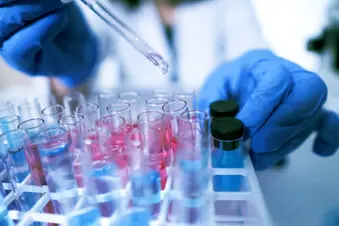
Michelle Anderson-Benjamin, a wife and mom of two, noticed back pain and a discharge from her right nipple during the pandemic. She went straight to her doctor, who ordered a mammogram. It was stage I triple-negative breast cancer. Benjamin moved quickly to treatment including chemotherapy and several surgeries.
But last year, her cancer returned. This time it was more advanced. Benjamin took the leap and joined a clinical trial. “I call it jumping out of a plane without a parachute because you’re taking a chance,” Benjamin says. “I knew about clinical trials from working in health care, and I also knew that people of color often suffered from not being involved in them.”
Clinical trials help experts learn about diseases and treatments. It’s in these settings that new and promising treatments for breast cancer are found. But oftentimes, Black women like Benjamin and other women of color are underrepresented in cancer trials.
Race and Breast Cancer
Breast cancer outcomes are improving, but it is still a leading cause of cancer death for women. White women are more likely to be diagnosed with breast cancer than other women, but Black women are more likely to have a more advanced and aggressive type and have worse outcomes.
Experts suggest a few reasons for this – from racism that leads to late diagnosis to a lack of trust many people of color have for health care. But more and more, the connection between clinical trials and better outcomes is front and center.
A 2014 study showed that almost 20% of new drugs approved had different effects depending on a person’s race.
“For life-threatening diseases like cancer, participation in a clinical trial is an important component of quality cancer care that may provide the only access to potentially promising anti-cancer treatments,” says Lola Fashoyin-Aje, MD, MPH, associate director of the Science & Policy Program to Address Disparities at the FDA. For many experts, testing a drug on people who may not use the drug as often is a tough pill to swallow. “The risk is that we continue to generate data that informs the safe and effective use of new therapies without consideration for the diversity of the population that will likely use the drug,” says Fashoyin-Aje.
Breaking Barriers
So why don’t more people of color join clinical trials? Research identifies a few factors that, if addressed, just might change things for the better. These include:
- Not being asked. Most patients find out about clinical trials from their doctors. But if the doctor doesn’t mention it, the opportunity is often missed. “The barriers to entry into breast cancer trials are not necessarily unique to breast cancer. There is a lack of education about clinical trials in general, and there is research that indicates that failure to offer clinical trials to patients may be one of the biggest barriers,” Fashoyin-Aje says.
- Strict rules to join. To join a clinical trial, you must meet certain standards (or criteria). These are in place to make sure the study is fair and balanced. Some overly strict criteria have kept people of color out. Things such as high blood pressure or hepatitis B that affect certain groups at a higher rate have been used in the past to rule out people of color. Some of this is changing as the medical community works with other groups to increase diversity.
- Distance from home. Joining a clinical trial often means regular in-person visits to a medical facility. Often these visits are a long distance (sometimes out of state or even the country) from certain diverse groups. If you don’t have reliable transportation or if you have other home responsibilities, just getting to the test site could be hard.
- Extra costs. Most costs that have to do with the trial are covered – such as the treatment itself, which can be a plus. But extra costs like parking, taxis, or hotels (and missing work) can add up and keep some groups from participating. “Participation in clinical trials can be quite burdensome like the time needed, trial-related costs, and more,” Fashoyin-Aye says.
- Real trust issues. Combine personal experience with some history of unethical medical practices and many people of color struggle to put full faith in what their doctors may suggest or prescribe. Many Black Americans were alive during (or have read about) the Tuskegee syphilis study on unaware Black men. Latinos may recall the birth control studies on Puerto Rican women without their knowledge. The resulting distrust can be a real barrier to signing up to lend your body to science.
Miranda Gonzales was a married mother of five when she found a lump in her breast. She got a mammogram (after being told she was too young at first at age 39) that confirmed her cancer. As she worked through her own treatment, Gonzales, a Mexican American, says she signed up for breast cancer clinical trials almost immediately. “I saw the benefit of having closer attention from doctors during my care," Gonzales says. “However, my biggest reason was knowing someone has to test these drugs. I’m trying to stay alive and felt it was my duty to help other women, as well.”
Building Equity in Research
Black Americans make up more than 13% of the U.S. population but only 2% to 9% of clinical trial participants for four new FDA-approved breast cancer treatments. Hispanic or Latin Americans make up 18.5% of the U.S. population but were only 0% to 9% of participants in those same trials.
The medical community is joining forces with community groups and corporations to spread the word about the need for diversity in trials.
Efforts like the FDA’s “Project Equity” or the National Institutes of Health’s “All of Us” program are working to engage people of color in both breast cancer and general research studies. Hospitals like Memorial Sloan Kettering Cancer Center and others across the country have plans to increase diversity in cancer research. One program involves language education to help researchers invite more people who may not speak and understand English well.
Gonzales, who is involved in the group For the Breast of Us, works as a translator for Latina women at clinics in rural areas. She talks with them about the importance of clinical trials. “I didn’t see a lot of women who looked like me,” she says. “I want to do more and be more.”
Research shows that growing diversity in trials includes using researchers who look like their study patients. “Patients are more likely to follow recommendations from their health care team when they identify with them,” Fashoyin-Aje says. Efforts across the country now include projects to raise the number of people of color in health care – both in labs and in doctors' offices.
So what should you do if you have been diagnosed with breast cancer and want to participate in a trial? Ask your doctor, Fashoyin-Aje says. If they don’t mention it to you first, experts agree that it’s OK to speak up and find out what might be available to you. Check out websites like www.clinicaltrials.gov to search for studies by topic.
People like Benjamin say they’re glad they signed up. “It can feel like the stacks are against me sometimes,” she says. “But I want to show my kids what resilience looks like, and what better example than their mother?”
Show Sources
SOURCES:
Lead Photo Credit: appledesign / Getty Images
Photo Credit: Gonzales: From the Breast of Us
Michelle Anderson-Benjamin, New York City, health administrator and community advocate.
American Society of Clinical Oncology (ASCO) Cancer.net: "Breast Cancer: About Clinical Trials."
CDC: "Basic Information About Breast Cancer."
Breastcancer.org: "Race/Ethnicity," “Special Report: Increasing Racial Diversity in Breast Cancer Clinical Trials.”
Association of Clinical Research Professionals: “How to Make Clinical Trials More Diverse and Inclusive.”
Lola Fashoyin-Aje, MD, MPH, associate director, Science & Policy Program to Address Disparities, Oncology Center of Excellence, FDA.
Miranda Gonzales, community advocate, Houston, TX.
FDA: “Project Equity.”
Memorial Sloan Kettering Cancer Center: “Increasing Diversity in Cancer Research.”
